I'm taking a week off from blogging so I can enjoy a needed break. I'll look forward to seeing you back here in the new year. Everyone have a safe and enjoyable holiday!
Monday, December 28, 2009
Friday, December 25, 2009
Four O'Clock Factoid: Canal Boats to Rapid Transit
Four O'Clock Factoid is a daily feature on Track Twenty-Nine helping to get you through the workday with a bit of useless knowledge.
Rochester, New York is home to an abandoned subway. Constructed in an abandoned segment of the Erie Canal, the line ran from 1927 until 1956. The route was grade separated for its entire length, but some interurban lines did connect from at-grade lines. In the downtown area, the canal was decked over with a new street, creating a subway. Trains ceased operating in 1956 when the eastern portion of the right-of-way was used to build an expressway.
Rochester, New York is home to an abandoned subway. Constructed in an abandoned segment of the Erie Canal, the line ran from 1927 until 1956. The route was grade separated for its entire length, but some interurban lines did connect from at-grade lines. In the downtown area, the canal was decked over with a new street, creating a subway. Trains ceased operating in 1956 when the eastern portion of the right-of-way was used to build an expressway.
Photo Friday: White Washed
Photo Friday is a series showcasing a photo of mine each week. Enjoy!
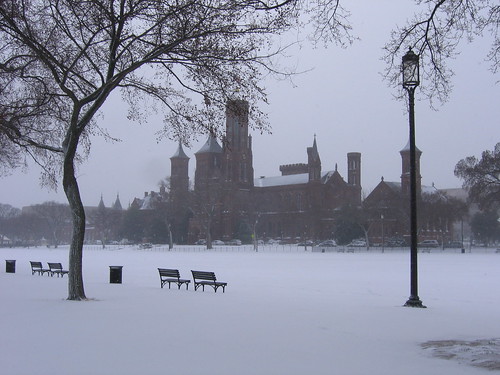
A blanket of snow covers the National Mall giving it an almost surreal feal

A blanket of snow covers the National Mall giving it an almost surreal feal
Thursday, December 24, 2009
Four O'Clock Factoid: Turbotrain
Four O'Clock Factoid is a daily feature on Track Twenty-Nine helping to get you through the workday with a bit of useless knowledge.
In an effort to improve passenger service in North America, the TurboTrain was introduced by Canadian National for runs between Toronto and Montreal in 1968. The train also began runs in the United States in 1968 on the New Haven Railroad. The train used gas turbine engines for propulsion and its lightweight, articulated design gave it a speed advantage over traditional trains in North America. The TurboTrain set the North American speed record for a production train at 170.8 miles per hour on December 20, 1968 on the Northeast Corridor between Trenton and New Brunswick.
In an effort to improve passenger service in North America, the TurboTrain was introduced by Canadian National for runs between Toronto and Montreal in 1968. The train also began runs in the United States in 1968 on the New Haven Railroad. The train used gas turbine engines for propulsion and its lightweight, articulated design gave it a speed advantage over traditional trains in North America. The TurboTrain set the North American speed record for a production train at 170.8 miles per hour on December 20, 1968 on the Northeast Corridor between Trenton and New Brunswick.
Wednesday, December 23, 2009
Four O'Clock Factoid: Transit, Compromise, Renewal
Four O'Clock Factoid is a daily feature on Track Twenty-Nine helping to get you through the workday with a bit of useless knowledge.
When PATH took over the Hudson and Manhattan Railroad in 1962, it represented a compromise decades in the making. The construction of the World Trade Center proved too difficult a compromise for New York and New Jersey to agree on. Allowing the Port Authority to take over the Hudson and Manhattan to create a site for the World Trade Center at the H&M Terminal gave New Jersey an incentive to participate. And the creation of a major employment center rejuvenated ridership on PATH.
When PATH took over the Hudson and Manhattan Railroad in 1962, it represented a compromise decades in the making. The construction of the World Trade Center proved too difficult a compromise for New York and New Jersey to agree on. Allowing the Port Authority to take over the Hudson and Manhattan to create a site for the World Trade Center at the H&M Terminal gave New Jersey an incentive to participate. And the creation of a major employment center rejuvenated ridership on PATH.
Wednesday Wrap: 12/23
Wednesday Weekly Wrap-Up is a feature looking back on transportation and planning news and opinions from the last week or so.
- Raise the Roof: CSX is speeding up plans for a National Gateway, which I talked about in September.
- More Trains, More Riders: Amtrak's new Lynchburg-Washington service, subsidized by Virginia, is beating ridership projections.
- Bypass the EIS on the NEC: So opines the Boston Globe, regarding the potential loss of stimulus money for improvements to the Northeast Corridor.
- Future, meet Past: Workers building Minneapolis-Saint Paul's Central Corridor light rail line recently unearthed a relic of transit from the early days.
- Recession Hurts Transit: APTA reports that rail ridership was down in the first 9 months of 2009, mainly due to unemployment.
Tuesday, December 22, 2009
Four O'Clock Factoid: 'Tear Down This Wall'
Four O'Clock Factoid is a daily feature on Track Twenty-Nine helping to get you through the workday with a bit of useless knowledge.
On December 22, 1989 the Brandenburg Gate reopened. For just under 3 decades, the famous landmark had been located within the death strip within the Berlin Wall. Today the gate continues to be a symbol of the city of Berlin and of German reunification.
On December 22, 1989 the Brandenburg Gate reopened. For just under 3 decades, the famous landmark had been located within the death strip within the Berlin Wall. Today the gate continues to be a symbol of the city of Berlin and of German reunification.
Transit Tuesday: Elevated Underground
Transit Tuesday is a weekly feature or profile on transit.
When Washington’s rapid transit system was being planned, regional leaders specifically shied away from calling it a subway, primarily because much of the network would not be below ground. Of course, even in cities where terms like “subway” and “elevated” are used, trains are not exclusively above or below ground.
The graphs below compare America’s heavy rail system based on their relationship to the ground: how much they’re on it, under it, or above it. The first chart shows the total system mileage in each category, while the second chart shows the percentage of the system in each category.


If any system deserves the moniker "subway" it's Los Angeles, where everything except for the rail yard is underground. New York's famous subway is only 56% underground. And Chicago's L (for 'elevated') has nothing on Miami, with its high water table. Miami has no underground sections, and only a few places where it runs at grade. Miami is 95% elevated, while Chicago's L is only elevated 54% of the time.
In addition to the aboveground/underground descriptors, all-capital acronyms caught on briefly. As did 'metros,' which can be found from Washington to Los Angeles and Miami to Baltimore, along with in places around the globe.
When Washington’s rapid transit system was being planned, regional leaders specifically shied away from calling it a subway, primarily because much of the network would not be below ground. Of course, even in cities where terms like “subway” and “elevated” are used, trains are not exclusively above or below ground.
The graphs below compare America’s heavy rail system based on their relationship to the ground: how much they’re on it, under it, or above it. The first chart shows the total system mileage in each category, while the second chart shows the percentage of the system in each category.


If any system deserves the moniker "subway" it's Los Angeles, where everything except for the rail yard is underground. New York's famous subway is only 56% underground. And Chicago's L (for 'elevated') has nothing on Miami, with its high water table. Miami has no underground sections, and only a few places where it runs at grade. Miami is 95% elevated, while Chicago's L is only elevated 54% of the time.
In addition to the aboveground/underground descriptors, all-capital acronyms caught on briefly. As did 'metros,' which can be found from Washington to Los Angeles and Miami to Baltimore, along with in places around the globe.
Monday, December 21, 2009
Meta Post: Regular Features
I recently introduced several new features to Track Twenty-Nine. For several weeks now, you have been seeing at least one post each weekday here. I hope that you find these posts engaging and interesting. In addition to the regular features, I still continue to post irregular posts on a variety of topics as I get a chance.
I'd like to get a sense of what you think of Track Twenty-Nine's regular features. I've set up a poll on the T29 main page. It will appear at top right. If you read through a feed reader, please come on over to the site and vote.
Please vote to let me know what your favorite feature is.
Any comments about the poll or the features can be made in this thread.
As always, thanks for reading!
Four O'Clock Factoid: The People's Subway
Four O'Clock Factoid is a daily feature on Track Twenty-Nine helping to get you through the workday with a bit of useless knowledge.
The Moscow Metro is the world's second-busiest, carrying over 7 million passengers each weekday. Many of the stations are notable for their rich architectural design. This concept was rooted in Russia's socialist tradition, and indicates the designers' belief that this was to be a space for the people.
The Moscow Metro is the world's second-busiest, carrying over 7 million passengers each weekday. Many of the stations are notable for their rich architectural design. This concept was rooted in Russia's socialist tradition, and indicates the designers' belief that this was to be a space for the people.
Snowpocalypse 2009
Washington received record-breaking snowfall for December over the weekend. Like every other blogger on the eastern seaboard, I've decided to post my pictures from the adventure. Most of mine were taken near my apartment in Greenbelt, Maryland.
If you're planning on visiting Washington anytime soon, bring a shovel.
If you're planning on visiting Washington anytime soon, bring a shovel.
Monday Shot: Honeycomb
Monday Shot isn't quite espresso, but hopefully this weekly transit picture will help get your week started.
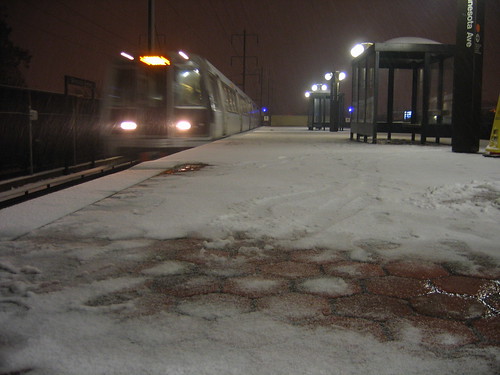
Snow covers the honeycomb-like pattern of Metro's Minnesota Avenue station.
My photostream

My photostream
Friday, December 18, 2009
Four O'Clock Factoid: Riding the Waves
Four O'Clock Factoid is a daily feature on Track Twenty-Nine helping to get you through the workday with a bit of useless knowledge.
The Florida Overseas Railroad was an extension of the Florida East Coast Railway to Key West. The line ran from 1912 to 1935. Upon completion in 1912, it was widely known as the "Eighth Wonder of the World." Much of the railroad was destroyed in a 1935 hurricane and the FEC sold the right-of-way to the state of Florida, which later used the infrastructure to build the "Overseas Highway" (US 1) to Key West.
The Florida Overseas Railroad was an extension of the Florida East Coast Railway to Key West. The line ran from 1912 to 1935. Upon completion in 1912, it was widely known as the "Eighth Wonder of the World." Much of the railroad was destroyed in a 1935 hurricane and the FEC sold the right-of-way to the state of Florida, which later used the infrastructure to build the "Overseas Highway" (US 1) to Key West.
Photo Friday: Rosslyn Sunset
Photo Friday is a series showcasing a photo of mine each week. Enjoy!
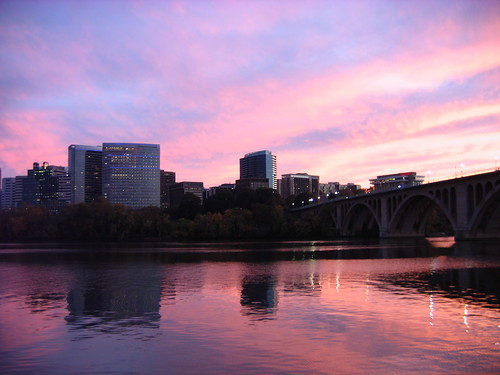
The Potomac is an excellent mirror for the November sky in the evening

The Potomac is an excellent mirror for the November sky in the evening
Thursday, December 17, 2009
Four O'Clock Factoid: TGV
Four O'Clock Factoid is a daily feature on Track Twenty-Nine helping to get you through the workday with a bit of useless knowledge.
In 1981, France's SNCF began operating the TGV service between Paris and Lyon. Introduction of the TGV was the first modern high-speed rail service on the European continent. One innovation of the TGV was that trains shared tracks with other trains in city centers, but used their own exclusive tracks, known as LGVs, for the long-haul.
In 1981, France's SNCF began operating the TGV service between Paris and Lyon. Introduction of the TGV was the first modern high-speed rail service on the European continent. One innovation of the TGV was that trains shared tracks with other trains in city centers, but used their own exclusive tracks, known as LGVs, for the long-haul.
Wednesday, December 16, 2009
Four O'Clock Factoid: F for Fancy
Four O'Clock Factoid is a daily feature on Track Twenty-Nine helping to get you through the workday with a bit of useless knowledge.
F Units are a well-recognized line of diesel-electric railway engines produced by General Motors' Electro-Motive Division. These smoothly curving engines were very successful after their introduction in 1939 and played a major role in replacing steam power in North American railroading. While many associate their clean lines with crack passenger expresses, they were actually designed for freight service.
F Units are a well-recognized line of diesel-electric railway engines produced by General Motors' Electro-Motive Division. These smoothly curving engines were very successful after their introduction in 1939 and played a major role in replacing steam power in North American railroading. While many associate their clean lines with crack passenger expresses, they were actually designed for freight service.
Wednesday Wrap: 12/15/09
Wednesday Weekly Wrap-Up is a feature looking back on transportation and planning news and opinions from the last week or so.
- A Sunset Every Day: At least one blog is reporting, with high confidence, that Amtrak is working to increase the frequency of the New Orleans-Los Angeles Sunset Limited to 7 days a week.
- Cheaper NEC Tickets?: New language in the DOT funding bill could mean cheaper Amtrak fares for commuter-oriented trains.
- Downeaster going Northeaster?: Maine is hoping to get word soon that it's received stimulus money to extend the Amtrak Downeaster, which currently runs from Boston North Station to Portland, on up to Brunwick.
- MoDot hopes for faster Trains: Like Maine, the Show Me state is hoping for stimulus funds to improve Amtrak service.
- Chalk another one up to Measure R: Los Angeles is now planning another light rail line, this one running from near LAX to the new Expo Line via Crenshaw.
- AirBART not up-in-the-air: Looks like a BART-OAK connector is in the works after all. The guideway will link the Coliseum BART stop with Oakland Airport in 14 minutes at an estimated cost of $12. BART recently awarded the contract for the project.
Tuesday, December 15, 2009
Four O'Clock Factoid: Olympiapark
Four O'Clock Factoid is a daily feature on Track Twenty-Nine helping to get you through the workday with a bit of useless knowledge.
Munich's Olympiapark is a lasting reminder of the 1972 Olympic Games. The area converted a former airfield into a vast district home to a variety of venues, a village, and parkland. Today, the site is still a major recreational and cultural center. It is in stark contrast to some cities, like Atlanta, where little is left in the urban form as a legacy from the games.
Munich's Olympiapark is a lasting reminder of the 1972 Olympic Games. The area converted a former airfield into a vast district home to a variety of venues, a village, and parkland. Today, the site is still a major recreational and cultural center. It is in stark contrast to some cities, like Atlanta, where little is left in the urban form as a legacy from the games.
Peachtree Proliferation
Atlanta has long been known for a proliferation of Peachtrees. Stemming from the importance and prestige of the original Peachtree Street, many other roadways in Georgia’s capital and the surrounding counties include “Peachtree” in their name. In fact, in the 5 core counties, some 68 roadways carry the name.
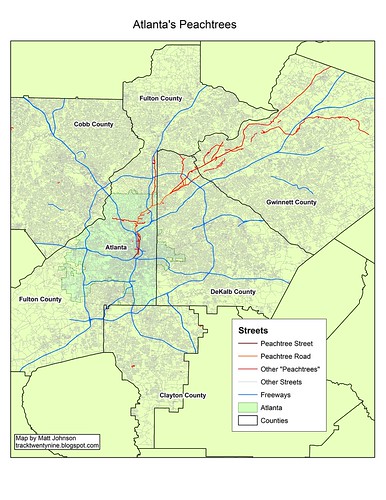
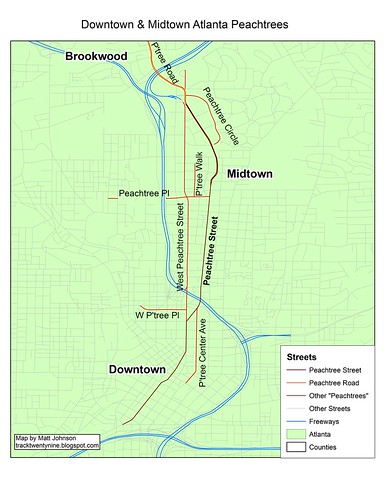

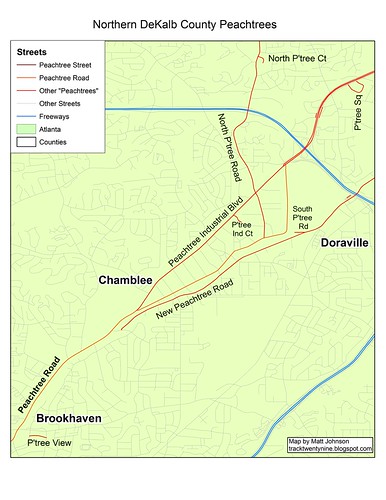
Of the five core counties in the Metro area, Cobb County has the fewest Peachtrees, with just three. Cobb’s Peachtree streets include:
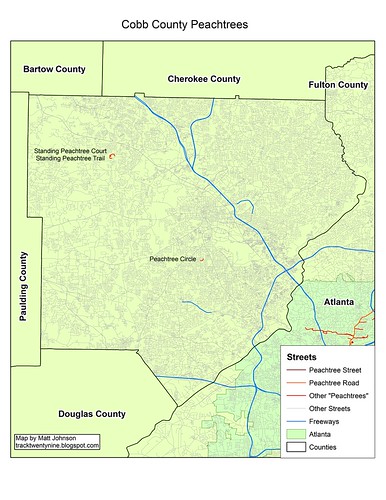
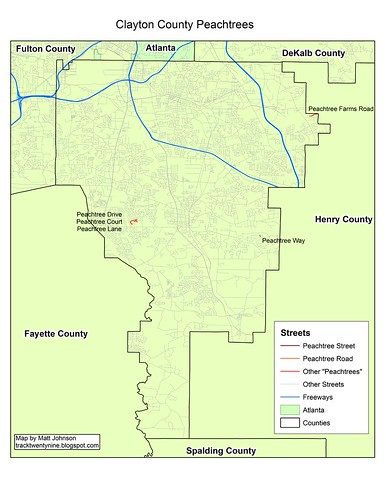
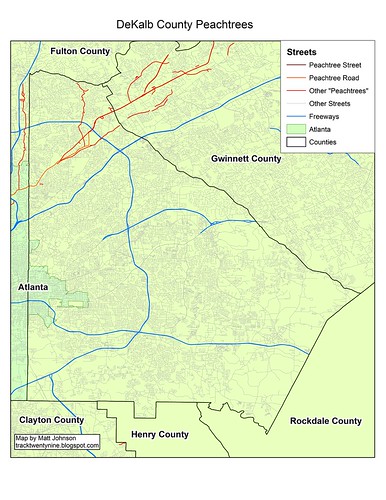






Below is a listing of the Peachtrees by county. If it is not noted that a street continues into a different county, then any street with the same name in more than one county is a duplicate. The Peachtree Circle in Cobb County is a completely different street than the Peachtree Circle in Atlanta and the Peachtree Circle in Gwinnett County.
Of the five core counties in the Metro area, Cobb County has the fewest Peachtrees, with just three. Cobb’s Peachtree streets include:
- Peachtree Circle
- Standing Peachtree Court
- Standing Peachtree Trail

- Peachtree Drive
- Peachtree Court
- Peachtree Farms Road
- Peachtree Lane
- Peachtree Way

- North Peachtree Court
- North Peachtree Road
- North Peachtree Way
- New Peachtree Road
- Peachtree Boulevard
- Peachtree Industrial Boulevard - continues into Gwinnett County
- Peachtree Industrial Court
- Peachtree North Court
- Peachtree Place Parkway
- Peachtree Road - continues into the City of Atlanta
- Peachtree Square
- Peachtree View
- South Peachtree Road

- Peachtree Dunwoody Circle
- Peachtree Dunwoody Court
- Peachtree Dunwoody Road - continues into the City of Atlanta
- Peachtree Hollow Court
- Peachtree Avenue
- Peachtree Battle Avenue
- Peachtree Battle Circle
- Peachtree Battle Place
- Peachtree Center Avenue
- Peachtree Circle
- Peachtree Drive
- Peachtree Dunwoody Road - continues into Fulton County
- Peachtree Hills Avenue
- Peachtree Hills Circle
- Peachtree Memorial Drive
- Peachtree Park Drive
- Peachtree Place
- Peachtree Road - continues into DeKalb County
- Peachtree Street
- Peachtree Valley Road
- Peachtree Walk
- Peachtree Way
- Spring West Peachtree Connector
- West Peachtree Place
- West Peachtree Street

- North Peachtree Street
- Old Peachtree Road
- Peachtree Bluff Court
- Peachtree Chase
- Peachtree Circle
- Peachtree Corners Circle
- Peachtree Corners East
- Peachtree Crest Drive
- Peachtree Forest Avenue
- Peachtree Forest Drive
- Peachtree Forest Terrace
- Peachtree Industrial Boulevard - continues into DeKalb County
- Peachtree Lakes Drive
- Peachtree Parc Court
- Peachtree Parc Lane
- Peachtree Parkway
- Peachtree Place
- Peachtree Road
- Peachtree Ridge Court
- Peachtree Ridge Drive
- Peachtree Street
- Peachtree Walk
- South Old Peachtree Road
- South Peachtree Street
- West Peachtree Street

Transit Tuesday: Commuter Rail "Balance"
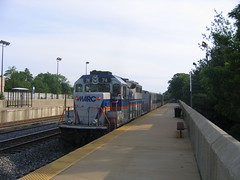 Transit Tuesday is a weekly feature or profile on transit.
Transit Tuesday is a weekly feature or profile on transit.I wrote recently about the “Rail Transit Continuum.” In that post I made a distinction between commuter rail and regional rail, using service characteristics to draw the line. Commuter rail lines, I said, are primarily oriented toward getting suburbanites into the city center for work. Regional Rail, on the other hand, acts more like a metro system, with more frequent trains running in both directions.
This week, Transit Tuesday takes a look at the “balance” America’s commuter rail operators. Some operators are very imbalanced, with most or all trains running only inbound during the morning. Other systems have a better balance of inbound and outbound trains during the morning and evening peaks.

Click for a larger image
Graphic Notes:
In the above graphic, inbound trips are shown in blue, outbound in red. The bars represent the total number of arrivals or departures at the primary terminal(s) of the network. The “balance” can be seen as how close each agency’s inbound and outbound bars are to each other. The graphic only shows trains arriving or departing at the central city terminal between their opening and 9:30 AM (inclusive).
For systems with more than one major city, the largest city is considered to be the destination of inbound trips. So in the Washington-Baltimore region, for instance, MARC trains are "inbound" toward Washington. The city used as the inbound destination is shown along the graphic’s y-axis, to the left of the dash.
In the case of New York, inbound trains on NJ Transit’s commuter rail lines end at one of four locations, NYC Penn Station, Hoboken, or Newark Penn Station in the New York area, and 30th Street - Philadelphia for the Atlantic City Line. For the totaling, any inbound trip terminating at one of those four stations is considered as an inbound trip. The same can be said for outbound, departing trips.
Trains that continue through the central city terminal, as is the case with SEPTA Regional Rail trains, are counted as both an inbound and outbound trip. However, trains which pass through the center city terminal, but do not continue to the suburbs are only considered an inbound trip.
Discussion:
Of the 22 commuter rail operators in the United States, only one has no reverse-commute trains. That service is the Altamont Commuter Express, which operates from Stockton to San Jose in California. The other systems all have at least one, though not on all the lines they operate.
Some commuter/regional rail operators would be expected to have good parity between peak-direction and reverse-commute trains based on the structure of their regions. South Florida’s Tri-Rail and Dallas-Fort Worth’s TRE both operate between major cities, so significant amounts of commuting in the opposite direction from the peak is predictable. But other cities with more monocentric downtowns sometimes have reverse-commute service on par with their peak-direction service. Examples include Nashville and Albuquerque.
Three systems actually have more outbound than inbound trains in the AM peak. This is probably an artifact of railyard location or some other operating constraint. However, Caltrain, FrontRunner, and Tri-Rail each have at least 2 more reverse-commute trains than peak-direction trains.
Another three systems have perfect parity, with the same number of inbound arrivals and outbound departures. These include Portland’s WES, Nashville’s Music City Star, and Dallas’ TRE.
Other than San Jose’s ACE, the worst ratio of outbound to inbound trains is VRE’s, which has 1 morning outbound train (on the Manassas Line) and 12 inbound trains (total). Seattle’s 2 outbound trains to 11 inbound trains is also a ratio that has room for improvement.
Monday, December 14, 2009
Four O'Clock Factoid: Air Pressure
Four O'Clock Factoid is a daily feature on Track Twenty-Nine helping to get you through the workday with a bit of useless knowledge.
The Peachtree Center Station on Atlanta's MARTA system is 120 feet deep. It was carved from solid gneiss. Due to the geology, pressurized air was required to keep the station from collapsing during construction. Workers had to undergo 30 minutes of compression/decompression when entering/leaving the site. It opened September 11, 1982.
The Peachtree Center Station on Atlanta's MARTA system is 120 feet deep. It was carved from solid gneiss. Due to the geology, pressurized air was required to keep the station from collapsing during construction. Workers had to undergo 30 minutes of compression/decompression when entering/leaving the site. It opened September 11, 1982.
Monday Shot: Ride the Rocket
Monday Shot isn't quite espresso, but hopefully this weekly transit picture will help get your week started.

A TTC streetcar bound for Union Station glides by in front of Toronto's skyline
My photostream

My photostream
Friday, December 11, 2009
Four O'Clock Factoid: Donner Summit
Four O'Clock Factoid is a daily feature on Track Twenty-Nine helping to get you through the workday with a bit of useless knowledge.
The Summit Tunnel near the top of the Donner Pass along with the railroad approaches to it constituted the most difficult engineering feat in the construction of the Central Pacific Railroad. Completed in 1868, it was in continuous use until 1993, when Southern Pacific abandoned the route in favor of the newer, lower Tunnel #41.
The Summit Tunnel near the top of the Donner Pass along with the railroad approaches to it constituted the most difficult engineering feat in the construction of the Central Pacific Railroad. Completed in 1868, it was in continuous use until 1993, when Southern Pacific abandoned the route in favor of the newer, lower Tunnel #41.
Photo Friday: Boats on the Water
Photo Friday is a series showcasing a photo of mine each week. Enjoy!
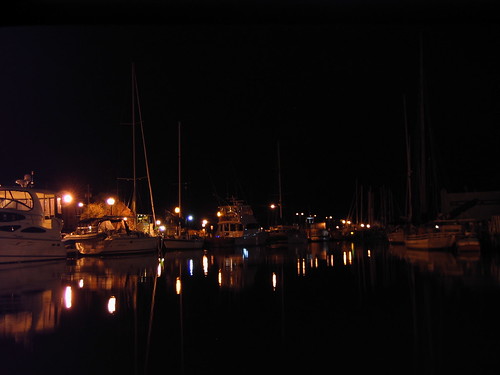
Boats moored in Annapolis' harbor offer an interesting light show at night.

Boats moored in Annapolis' harbor offer an interesting light show at night.
Thursday, December 10, 2009
Four O'Clock Factoid: Luxury and Intrigue
Four O'Clock Factoid is a daily feature on Track Twenty-Nine helping to get you through the workday with a bit of useless knowledge.
The Orient Express is perhaps one of the best-known trains in the world. Since its debut in 1883 as a train running between Paris and Istanbul, several different routes, origins, and destinations have been used with the brand. Today's Orient Express operates between Strasbourg and Vienna.
The Orient Express is perhaps one of the best-known trains in the world. Since its debut in 1883 as a train running between Paris and Istanbul, several different routes, origins, and destinations have been used with the brand. Today's Orient Express operates between Strasbourg and Vienna.
Arlington's Systemic Streets
Earlier this year, we explored the nature of Washington's street-naming system. Across the Potomac, Arlington County also has rhyme and reason to street names.
While Arlington was originally part of the District of Columbia (until 1846), it was not incorporated in the plan of Pierre L'Enfant. Unlike its larger neighbor, Arlington's streets don't follow a strict grid, but development has still followed a somewhat rectilinear pattern. The street-naming system dates back to 1932, and was undertaken in order to convince the Postal Service to allow "Arlington" as the mailing address for the entire county.
The county is divided into northern and southern sections by Arlington Boulevard, a major east-west thoroughfare which bisects the county.
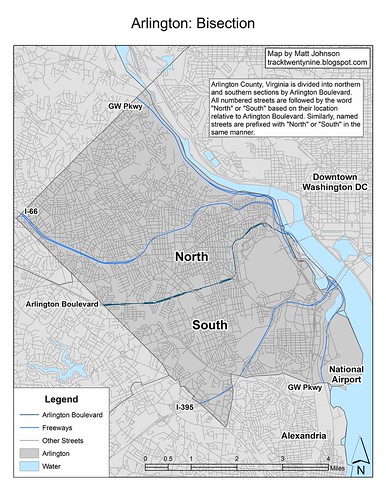

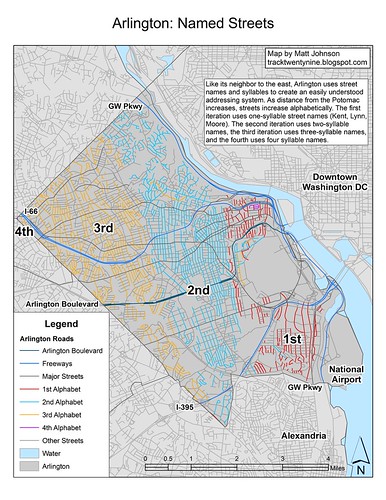
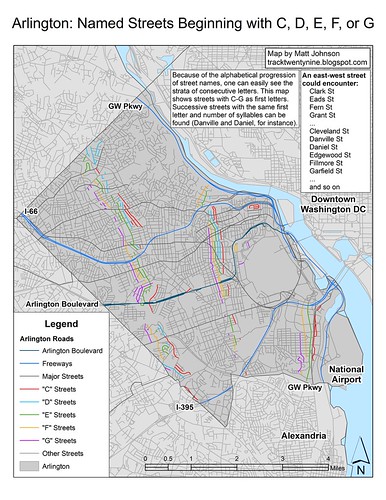
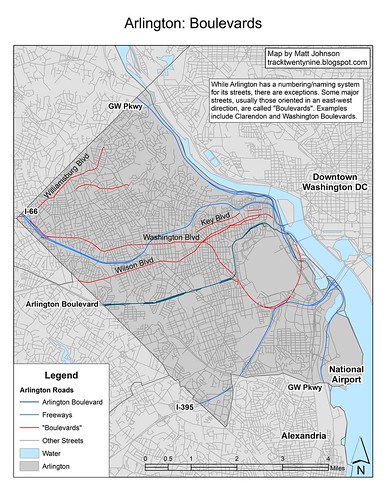
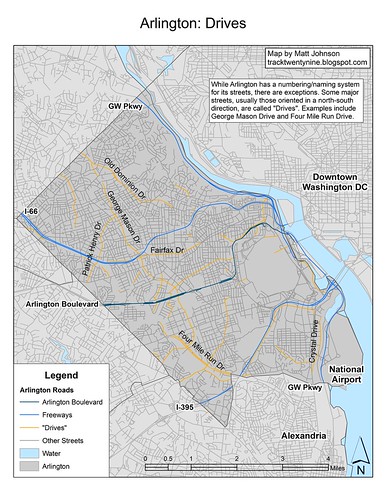
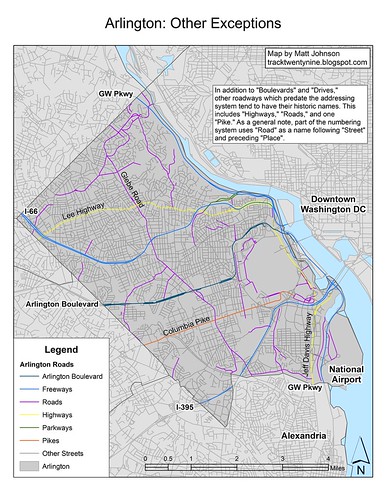
While Arlington was originally part of the District of Columbia (until 1846), it was not incorporated in the plan of Pierre L'Enfant. Unlike its larger neighbor, Arlington's streets don't follow a strict grid, but development has still followed a somewhat rectilinear pattern. The street-naming system dates back to 1932, and was undertaken in order to convince the Postal Service to allow "Arlington" as the mailing address for the entire county.
The county is divided into northern and southern sections by Arlington Boulevard, a major east-west thoroughfare which bisects the county.







Wednesday, December 9, 2009
Four O'Clock Factoid: 126 MPH
Four O'Clock Factoid is a daily feature on Track Twenty-Nine helping to get you through the workday with a bit of useless knowledge.
The Mallard was a LNER Class A4 locomotive which set the world speed record for a steam locomotive at 126 miles per hour on July 3, 1938. Mallard operated on the London and Northeastern Railway until April 1963. It was 5 months old when it set the record.
The Mallard was a LNER Class A4 locomotive which set the world speed record for a steam locomotive at 126 miles per hour on July 3, 1938. Mallard operated on the London and Northeastern Railway until April 1963. It was 5 months old when it set the record.
Wednesday Wrap: 12/9/09
Wednesday Weekly Wrap-Up is a feature looking back on transportation and planning news and opinions from the last week or so.
- Newsbreak: Better bus service increases ridership: One wonders why we don't do more of this. Everett's new Swift BRT will likely increase transit ridership. Hopefully we'll see more arterial bus improvements around the nation.
- Light Rail for Florida: Pinellas County Florida has officially added light rail to long-term plans. By 2033 a line could be operating between Saint Pete and Clearwater.
- Rain Good for Streetcars: There must be something in the rain. Another Pacific Northwestern city, Spokane, is looking at Streetcars. If Portland is any indication, they can't go wrong.
- Lay down the Trails and tear up the Tracks: Work is finally starting on Atlanta's Beltline corridor. The first step is removing the old tracks. So far the oldest rail that's been found dates to 1904.
- SunRail moving forward: Florida's House of Representatives passed a commuter rail bill in special session this week. And the Senate followed suit. Governor Crist has promised to sign the legislation. The bill would help maintain Miami's Tri-Rail and would set up commuter rail in central Florida.
- Come on ride the Train: Amtrak saw record ridership over Thanksgiving.
- LaHood takes on Coburn: Secretary of Transportation, Ray LaHood recently wrote a post on the DOT's blog challenging Oklahoma Senator Coburn's worldview. Well, at least his view of alternative transportation.
Tuesday, December 8, 2009
Four O'Clock Factoid: AICP
Four O'Clock Factoid is a daily feature on Track Twenty-Nine helping to get you through the workday with a bit of useless knowledge.
The American Institute of Certified Planners is the professional organization for planners in the United States. Like other professional organizations, the AICP and it's parent organization, the American Planning Association, assists members with continuing education, professional development, and the standards of the practice.
The American Institute of Certified Planners is the professional organization for planners in the United States. Like other professional organizations, the AICP and it's parent organization, the American Planning Association, assists members with continuing education, professional development, and the standards of the practice.
Transit Tuesday: Bikes on Board
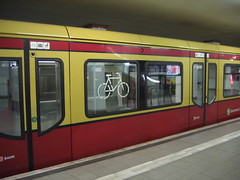 Transit Tuesday is a weekly feature or profile on transit.
Transit Tuesday is a weekly feature or profile on transit.Bikes and transit often seem to be a match made in heaven. When the bus is too infrequent or the walk just a bit too far, a bicycle can get a transit rider to a multitude of destinations. As a result of the increasing popularity of cycling and transit, many agencies are taking steps to include bikers. Today, Transit Tuesday looks at allowing bikes onboard railcars.
Lockouts
Heavy Rail
Six heavy rail systems have a bike “lockout” period during each rush hour because trains and stations are crowded. During these periods, cyclists must leave their bike at the station or ride to their destination. Systems with lockouts are: Boston T, Chicago L, Los Angeles Metro, PATH, Philadelphia (Broad Street & Market-Frankford), and Washington Metro. New York’s MTA has a lockout for bikes on the Staten Island Railway, but not the other subway services.
In contrast, San Francisco’s BART prohibits bikes on certain trains on specific parts of each line during rush hours, instead of a blanket lockout. This allows cyclists to use less-crowded trains operating in the off-peak direction or on inbound trains which are not yet crowded.
Other cities don’t have prohibitions on bikes during rush hours: Baltimore Metro, Cleveland Rapid, MARTA, Miami Metro, New York Subway, and the PATCO Speedline. However, Miami requires bikers to have a permit at all times of the day.
Boston prohibits cyclists from using the downtown transfer stations except to change lines. Cyclists may not enter or exit those stations at any time.
Light Rail
Among light rail systems, Boston’s Green and Mattapan Lines, Philadelphia’s light rail lines, and San Francisco’s Muni Metro are unique in barring bicycles at all times.
Houston, Hudson-Bergen, Newark, and Pittsburgh have rush hour bike prohibitions. Los Angeles bans bikes during rush hours on light rail trains in the peak direction only.
Commuter Rail
Two commuter rail systems have a blanket ban on cycles at all times: Maryland’s MARC and Chicago/Indiana’s South Shore Line.
SEPTA Regional Rail trains have a ban on bikes during rush hours.
Five systems ban bikes on peak direction trains during rush hours only. Those systems are: MBTA Commuter Rail, Chicago’s Metra, NJ Transit Commuter Rail, and New York’s Long Island and Metro North Railroads.
Virginia Railway Express bans bikes from certain trains, but it is possible to bring your bike on board some rush hour, peak direction trains.
The remaining 13 systems allow bikers on board at all times. They are: New Mexico Rail Runner, Trinity Railway Express, Los Angeles’ Metrolink, Miami’s Tri-Rail, Minneapolis’ Northstar, Nashville’s Music City Star, Connecticut’s Shore Line East, the FrontRunner in Salt Lake City, California’s Caltrain, Coaster, and ACE, Seattle’s Sounder, and Portland’s WES.
Permits are required in order for bikers to bring their cycles onboard Metro North and the Long Island Railroad. Cyclists can only board NJ Transit commuter trains at “accessible” stations (where the doors in the center of the coach open).
Car Capacity
Heavy Rail
Boston, Chicago, Cleveland, PATH, and Washington impose a limit of 2 bikes per car on weekdays. Miami allows up to 4 bikes per car, but bikes are only allowed in the last car of the train. PATH and BART do not allow cycles in the first car of the train. Other operators don’t specifically mention a limit on cycles per car, but all require that bikers avoid crowded trains.
Light Rail
San Diego’s Trolley has a limit of 1 bike per car during rush hours, 2 bikes per car otherwise. Buffalo, Cleveland’s light rail, and Houston have a limit of 2 bikes per car. Denver, Sacramento, Salt Lake City, Seattle, and Tacoma allow a maximum of 4 bikes per car. San Jose’s VTA allows 6 bikes per car, although they must remain in the center articulation area. Other cities don’t have specific limits on the number of bikes, although some mandate that cycles remain in certain areas of the car, which presents an inherent limit.
In Sacramento, the last train of the day in each direction has no bike limit.
Many light rail systems, because of handicap access and the high-floor nature of the cars have restrictions on which areas of the car can be used for bikes. Baltimore, Denver, Sacramento, and St. Louis disallow bikes from using the first door on the train, but Buffalo requires cycles to use the first door.
Pittsburgh’s LRT is a mix of high-platform “stations” and low-platform “stops.” Bikes can only board and alight at high-platform stations.
Commuter Rail
America’s newest commuter rail line, Minneapolis’ Northstar allows for one bike per car. Rail Runner, Metra, Metrolink, Tri Rail, and NJ Transit have maximums of around 2 bikes per car. Coaster and Sounder allow for up to 4 bikes per car. WES allows for 6 in each car.
Metro North and the Long Island Railroad have a limit of 4 bikes per train and require that bikes be in the first or last car, with a limit of two in each. SEPTA and VRE allow for only 2 bikes per train. In VRE’s case, cycles are required to be in the cab car.
The Bay Area seems to come out on top in regards to bike access to commuter rail. ACE allows for 34 bikes per train. And Caltrain, which claims to have the premiere bike-on-transit program, runs all trains with at least one “bike car.” This allows for a minimum of 40-48 bikes per train. Some trains have two bike cars, which doubles bike capacity.
Other systems don’t include maximum limits per car, but several require that bikes fit in the area reserved for ADA access, including the Music City Star and Trinity Railway Express. Even systems with maximums often require bikers to vacate space for disabled passengers, even to the point of leaving the train before their journey is finished. Few systems guarantee space for cycles, but more are moving in that direction. The Utah Transit Authority recently announced that they’re looking for ways to increase the amount of space for bikers on FrontRunner.
Monday, December 7, 2009
Four O'Clock Factoid: Speeding
Four O'Clock Factoid is a daily feature on Track Twenty-Nine helping to get you through the workday with a bit of useless knowledge.
1994's Speed featured several parts of the LA area's transit system. Much of the film takes place on a bus, ostensibly a Santa Monica Big Blue Bus. During the early parts of the film, the bus uses the I-105 freeway, which was nearing completion at the time. In the background of many shots, one can see the tracks of LA's Green Line, also under construction at the time. Later in the film, LA's Metro plays a prominent role, eventually crashing through the construction at the end of the line to wind up on Hollywood Boulevard.
1994's Speed featured several parts of the LA area's transit system. Much of the film takes place on a bus, ostensibly a Santa Monica Big Blue Bus. During the early parts of the film, the bus uses the I-105 freeway, which was nearing completion at the time. In the background of many shots, one can see the tracks of LA's Green Line, also under construction at the time. Later in the film, LA's Metro plays a prominent role, eventually crashing through the construction at the end of the line to wind up on Hollywood Boulevard.
Meet Me Tomorrow
For those of you in the Washington/Baltimore region, I encourage you to come out to RFD tomorrow afternoon. Greater Greater Washington is having a Holiday Party. Feel free to come out and meet me and other GGW contributors and readers.
The event is at RFD's private room in the back at 7P on Tuesday.
RFD is located on 7th Street just north of H Street, near Gallery Place Metro.
Monday Shot: Oberbaum
Monday Shot isn't quite espresso, but hopefully this weekly transit picture will help get your week started.

Berlin's U-bahn crosses the Spree River on the Oberbaumbrücke, which was closed to trains from 1961-1995, in the aftermath of the Berlin Wall's construction.
My photostream

My photostream
Friday, December 4, 2009
Four O'Clock Factoid: Rack 'em and Stack 'em
Four O'Clock Factoid is a daily feature on Track Twenty-Nine helping to get you through the workday with a bit of useless knowledge.
New York County, synonymous with the borough Manhattan, is the most densely populated county in the United States. In 2008, the average density of Manhattan was 71,201 persons per square mile. However, Manhattan is not the most populous of New York City's five boroughs. That distinction goes to Brooklyn.
New York County, synonymous with the borough Manhattan, is the most densely populated county in the United States. In 2008, the average density of Manhattan was 71,201 persons per square mile. However, Manhattan is not the most populous of New York City's five boroughs. That distinction goes to Brooklyn.
Photo Friday: Alberta Bound
Photo Friday is a series showcasing a photo of mine each week. Enjoy!
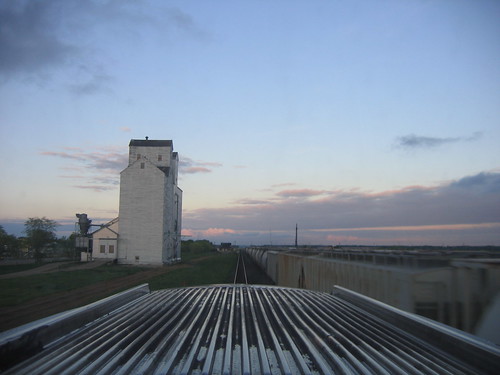
I captured this shot of a dusky sky from the observation dome of the rear car of Via's Canadian.
My Photostream

I captured this shot of a dusky sky from the observation dome of the rear car of Via's Canadian.
My Photostream
Thursday, December 3, 2009
Four O'Clock Factoid: Rollin' Down the Seaboard Line
Four O'Clock Factoid is a daily feature on Track Twenty-Nine helping to get you through the workday with a bit of useless knowledge.
In 1965, Johhny Cash popularized the song Orange Blossom Special, a song named after the famed train of the same name. The Orange Blossom ran from New York Penn Station to Miami or St. Petersburg, Florida. The train operated from 1925-1953 over the Pennsylvania Railroad, the RF&P, and the Seaboard Airline Railroad.
In 1965, Johhny Cash popularized the song Orange Blossom Special, a song named after the famed train of the same name. The Orange Blossom ran from New York Penn Station to Miami or St. Petersburg, Florida. The train operated from 1925-1953 over the Pennsylvania Railroad, the RF&P, and the Seaboard Airline Railroad.
Hey talk about a-ramblin'
She's the fastest train on the line.
Talk about a-travelin'
She's the fastest train on the line.
It's that Orange Blossom Special
Rollin' down the Seaboard line.
Wednesday, December 2, 2009
Four O'Clock Factoid: It's Electric!
Four O'Clock Factoid is a daily feature on Track Twenty-Nine helping to get you through the workday with a bit of useless knowledge.
The Black Mesa and Lake Powell Railroad is a private freight railroad operating in Arizona. It is noteworthy as an American railroad in that it is electrified. The line is used to carry coal from mines on the Black Mesa to a power plant near Lake Powell. It was constructed in the 1970s and is completely disconnected from the rest of the American rail network.
Here's a video from e44e33 on YouTube.
The Black Mesa and Lake Powell Railroad is a private freight railroad operating in Arizona. It is noteworthy as an American railroad in that it is electrified. The line is used to carry coal from mines on the Black Mesa to a power plant near Lake Powell. It was constructed in the 1970s and is completely disconnected from the rest of the American rail network.
Here's a video from e44e33 on YouTube.
Wednesday Wrap: 12/2
Wednesday Weekly Wrap-Up is a feature looking back on transportation and planning news and opinions from the last week or so.
- The Fast Bus: Washington state has its first BRT line. The "Swift" runs 17 miles from Everett to Shoreline and has stops about every 2 miles.
- A Streetcar Named 'Big D': Dallas is trying for several million dollars of federal funding for two new trolley routes to complement the successful DART light rail.
- Wave of the Future?: NPR considers the future of Personal Rapid Transit.
- Travel Week: This week is busy for all modes of transportation, and Amtrak is no exception. Two additional trains were added to the route of the Cascades in Washington and Oregon. Other trains ran full.
- A Troubled Bridge over Water: The New York Post reports that after years of underfunding, many of Amtrak's rail bridges in New York are in bad repair.
- Closer to South Coast Trains: Massachusetts and CSX are getting closer to an agreement to return passenger trains to the South Coast, perhaps by 2010.
- Sunshine State Looks at Rail: It looks likely that Florida's Legislature will hold a special session to consider commuter and high-speed rail.
- Save the Stations: The Detroit Free Press looks at how two cities managed to resurrect their rundown train stations. Can Detroit follow suit?
- OKC Without a Car: The mayor of Oklahoma City would like to see a city where you don't need a car to get around. And he's pushing a streetcar as one way to do that.
- Aloha Delays: Hawaii has decided to review the Honolulu LRT's EIS. This could delay the project, which was set to break ground in January or February.
Tuesday, December 1, 2009
Four O'Clock Factoid: Steely Resolve
Four O'Clock Factoid is a daily feature on Track Twenty-Nine helping to get you through the workday with a bit of useless knowledge.
Atlantic Station is a new master plan community in Atlanta. The brownfield redevelopment site was home to Atlantic Steel for many years, but the new quarter has breathed life into Atlanta's urban fabric. Despite ample amounts of parking, the urban form keeps pedestrians on the streets. And since its 2005 opening, new urbanism is all the rage in the city often known as a poster-child of sprawl.
Atlantic Station is a new master plan community in Atlanta. The brownfield redevelopment site was home to Atlantic Steel for many years, but the new quarter has breathed life into Atlanta's urban fabric. Despite ample amounts of parking, the urban form keeps pedestrians on the streets. And since its 2005 opening, new urbanism is all the rage in the city often known as a poster-child of sprawl.
Transit Tuesday: Last Train Out
Transit Tuesday is a weekly feature or profile on transit.
One thing that Washingtonians know is that it's often easier to take Metro. And for the most part, I think they're right. However, Metroing around has its limitations--especially after dark. The system is one of the first heavy rail systems in the United States to close every evening, and it is the first to start closing (unless you count CTA's Skokie Station).
Of course, WMATA is a chronically underfunded agency with many unmet needs. Still, it would seem on the surface to be essential for the subway to stay open late in Our Nation's Captial. While it is true that Washington has long held the distinction of being known as an early-to-bed, early-to-rise sort of town, they don't exactly roll up the sidewalks at 11:30. They do start rolling up the Metro, though. They start shutting it down at 11:24 every evening Sunday through Thursday.
 Most people agree that it would be better if Metro stayed open later--at least to a certain point. There seems to be little incentive or need to have trains running at 3 in the morning, but 12:30 doesn't strike me as unreasonable. Of course, Fridays and Saturdays tend to see demand for those really late night trains and when WMATA suggested cancelling them last year, there was a good deal of outcry.
Most people agree that it would be better if Metro stayed open later--at least to a certain point. There seems to be little incentive or need to have trains running at 3 in the morning, but 12:30 doesn't strike me as unreasonable. Of course, Fridays and Saturdays tend to see demand for those really late night trains and when WMATA suggested cancelling them last year, there was a good deal of outcry.
The early closing time of Metro does not seem to jibe fully with the maintenance argument. While WMATA is in the same league as some of the systems in terms of downtime, it is quite different from its peers. San Francisco's BART is 4 years older, MARTA is 3 years younger, both have less than 2.5 hours to do maintenance. The more extensive systems (Metro is second in distance, behind NYC Subway and just ahead of CTA) tend to have less downtime--none actually.
The point is that if Metro really wanted to extend service, it would be possible. Systems just as lengthy and of a similar era make do with less time for repairs. In some cases, notably Chicago and New York, places where the subway doesn't sleep, the maintenance issues are far more pronounced than Metro's. Chicago has more slow zones than you can count on all your fingers and New York's system faces the same sorts of problems that all centenarians face.
The maintenance issue is a non sequitur. Even if the maintenance that needed to be done was on a crossover, trains could still operate at 20 minute headways, which is just about right for late evenings. When switch work several weeks ago disrupted Green and Yellow service at Mount Vernon Square, trains operated every 20 minutes through two interlocking segments. Besides, Metro already does maintenance at night, often well before service ceases, but after passenger volumes have fallen off.
With high gas prices strangling the economy and a resurgence of interest in urban living, it is time for Metro to make significant improvements to its service. Later service is one step that can be taken. Even adding 30 minutes of service would be a considerable achievement for this, America's finest of subways.
Let's hope that soon Metro will be Opening Doors later and leaving the light on for a broader spectrum of riders.
What are your thoughts?
This week, Transit Tuesday is a repost of an earlier post since I've been traveling over the holiday. Look for a new Transit Tuesday next week.
One thing that Washingtonians know is that it's often easier to take Metro. And for the most part, I think they're right. However, Metroing around has its limitations--especially after dark. The system is one of the first heavy rail systems in the United States to close every evening, and it is the first to start closing (unless you count CTA's Skokie Station).
Of course, WMATA is a chronically underfunded agency with many unmet needs. Still, it would seem on the surface to be essential for the subway to stay open late in Our Nation's Captial. While it is true that Washington has long held the distinction of being known as an early-to-bed, early-to-rise sort of town, they don't exactly roll up the sidewalks at 11:30. They do start rolling up the Metro, though. They start shutting it down at 11:24 every evening Sunday through Thursday.
And while the party-goers and clubbers have the benefit of an extra 3 hours of service on Fridays and Saturdays, this strategy leaves out the idea of equity. After all, it's not just clubbers who are out after midnight. All of those service workers have to get home somehow, and many of them don't get off until late. Besides, do we really want to be known as the city that has the first subway to retire each night? Even Baltimore's Metro starts to close later than WMATA.
Let's have a look at the data. I created this bar chart to illustrate the service periods of America's 13 heavy rail systems. They are shown (from top to bottom) in ascending order of first last train. So, for instance, Washington has the first last train of all the systems, when the train bound for Greenbelt leaves Branch Avenue for the last time each weekday at 11:24. The three bottom-most systems don't close at all (although service patterns are different late at night) and Chicago keeps its Red and Blue Lines open all night.

Graphic Notes:
Opening: refers to the period between the earliest scheduled departure until all stations are open in all directions of travel.
Open: refers to the period when the entire system is in revenue service.
Closing: refers to the period between the last revenue departure at a station (in any direction) and the final revenue offload of the evening.
Example: WMATA is opening from 4:54, when the first Blue Line train leaves Largo, until 6:04, when the first train to leave Franconia arrives at Largo. WMATA starts closing at 11:24P, when the last train of the evening leaves Branch Avenue and is closed at 12:40, when the last train of the evening terminates at Shady Grove.
But what about the rest of the week? Where is the outcry then?
When I flew back from Vancouver (via Atlanta), I was subjected to weather delays. My flight pulled up to Gate 21 at National at 11:34 PM. I had just 10 minutes to get off the plane, clear the terminal, buy a farecard, and run up an escalator. I made it--with 4 minutes to spare. I don't know how. I might have broken some laws of physics to do it, but I wasn't about to sell my firstborn to pay for the cab ride to Prince George's Plaza. The fact of the matter is that 11:44 is far too early to stop inbound service on the most direct route from the Airport to Downtown.
In Atlanta, where the airport is not only a major visitor/resident destination, but also a major job center, the last train leaves at 1:00 AM sharp. Sure, it takes until 1:43 to get to Doraville, but I never had to worry about missing the last train, and while the train was never at crush, there is a lot that could be said about the benefits of mobility--and having a system that meets the needs of people other than suburban commuters is an essential aspect of a world-class transit system.
Of course there are larger issues at stake. It often seems that the only constants in Washington are humidity and a transit system with a perpetual funding crisis. (Which is funny, because I could say the same thing about Atlanta). And I certainly would not argue in favor of later service in the evening at the expense of rush hour service. And if we aren't cutting expenses somewhere, that means more outlays for operations. So what kind of money are we talking about here?
Well, the exact number isn't clear. According to WMATA, they charge venues $21,000 per hour to keep the system open late for special events (think evening Redskins games). It so happens that if a certain ridership threshhold is crossed, the venue gets their money back, and it's not uncommon for these events to keep the system open. So if we wanted the last train to leave Branch Avenue an hour and a half later at 12:54 AM, it would theoretically cost about $30,000 per day. That's $150,000 per week or about $600,000 over a month.
It's not quite that simple, though. While these are all back-of-the-napkin sorts of calculations, a permenant or long-term extension of service in the evening would likely come with a readjustment of bus services and the like, so it could wind up being slightly more expensive.
But of even greater concern to Metro is when they would do their maintenance. We all know what happens when Metro defers maintenance, and it isn't pretty. And 90 minutes less time to upgrade and repair tracks and stations is not a trivial amount of time. Still, other systems manage to do it.


The point is that if Metro really wanted to extend service, it would be possible. Systems just as lengthy and of a similar era make do with less time for repairs. In some cases, notably Chicago and New York, places where the subway doesn't sleep, the maintenance issues are far more pronounced than Metro's. Chicago has more slow zones than you can count on all your fingers and New York's system faces the same sorts of problems that all centenarians face.
The maintenance issue is a non sequitur. Even if the maintenance that needed to be done was on a crossover, trains could still operate at 20 minute headways, which is just about right for late evenings. When switch work several weeks ago disrupted Green and Yellow service at Mount Vernon Square, trains operated every 20 minutes through two interlocking segments. Besides, Metro already does maintenance at night, often well before service ceases, but after passenger volumes have fallen off.
With high gas prices strangling the economy and a resurgence of interest in urban living, it is time for Metro to make significant improvements to its service. Later service is one step that can be taken. Even adding 30 minutes of service would be a considerable achievement for this, America's finest of subways.
What are your thoughts?
Subscribe to:
Posts (Atom)









